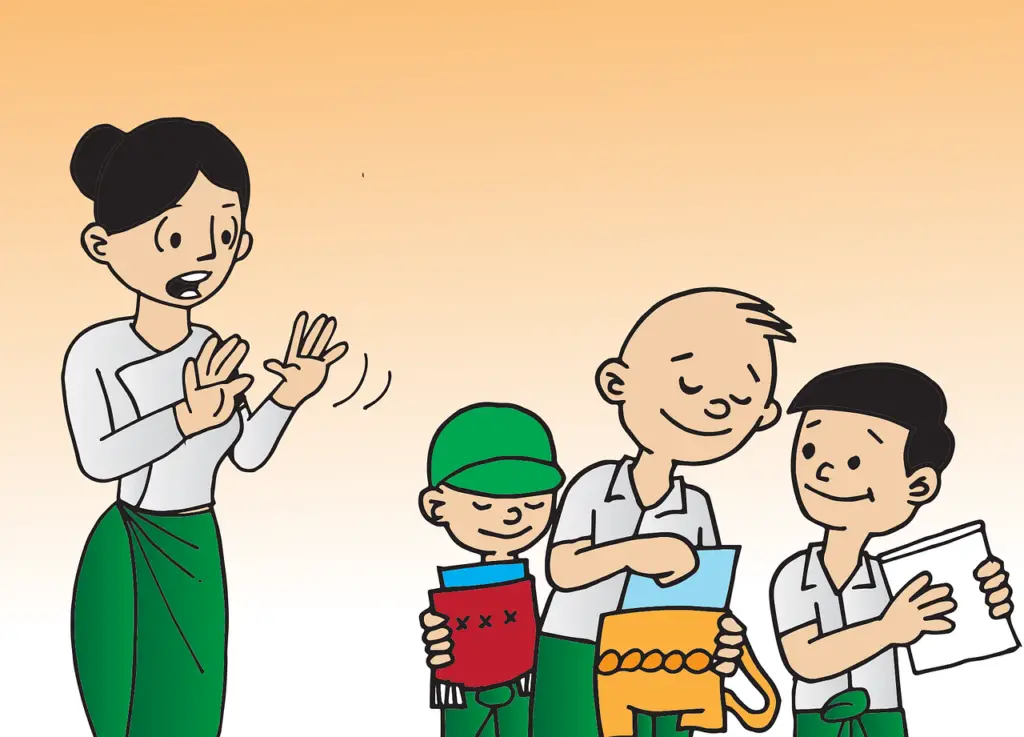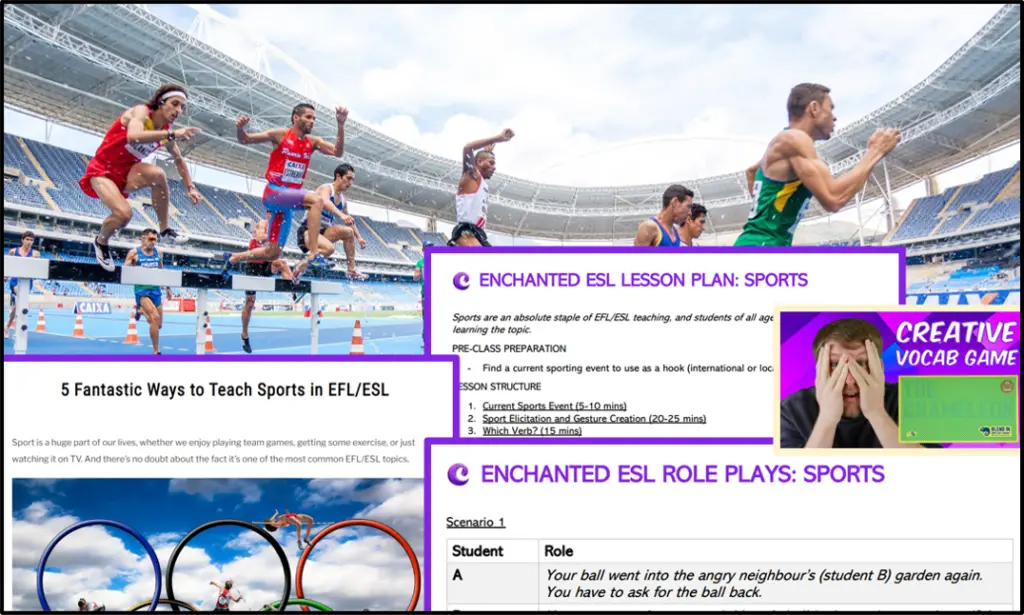Starting the class with an engaging, challenging game or activity sets the tone for the rest of the lesson. Instead of being greeted with a long grammar worksheet at the start of the session, students would much rather get warmed up with something short and exciting.
Warmup games are a staple of EFL/ESL teaching. The best ones need no explanation, with students able to get stuck in as soon as they walk into the room.

I’ve compiled a list of 9 of my favourite warmup games and activities here. Some are active and great for kids, while others are calm and focused, perhaps better for older students. They’re all light on setup and materials, so preparation time is very low!
Regardless of the makeup of your class, varying the warmup games keeps things fresh, so make sure you use plenty!
- Picture Prompts
- What’s Changed?
- Would You Rather
- Alphabet Race
- Creative Uses
- Simon Says
- Acrostic Challenge
- Hot Potato
- Who Am I? / What Am I?
The 9 warmup games on this list are a great place to start, but if you’re looking for more games with detailed instructions and adaptations for online, individual or group classes, I’ve got a free ebook with 20 of them.
You can get it, along with a treasure trove of other resources: role-play scenarios, lesson plans, game printables which you’ll get straight away by signing up to the Enchanted ESL Newsletter.

Enchanted ESL Resource Trove
- Lesson plans
- Role-play scenarios
- Printable game materials
- 20 ESL Games eBook
- Monthly newsletters with more free stuff!
1. Picture Prompts
This one is simple. When students enter the room, they’re greeted by a picture (printed, on a screen etc.).
Give them a little time to study the picture, then ask them to say what they see. You can change the picture and expectations depending on the level of your students.
- Beginner students: Pictures with lots of objects and people. They can say individual words or short sentences to describe what they see.
- Intermediate students: Pictures of individual objects, rooms or people. Focus on details, actions and what the people in the picture might be feeling.
- Advanced students: Abstract images. Students can express how the pictures make them feel.
TIPS:
- Consider getting students to write down their ideas when they enter so they’re ready to say something.
- With a large group, make sure each student has the opportunity to say at least one thing about the picture.
- Transition into a Packed Pictures elicitation activity for gaining new vocabulary. For more on how to do that, read my article: How to Elicit Vocabulary in EFL/ESL: 7 Effective Activities.
2. What’s Changed?
Usually, What’s Changed sees a student go out of the class, everyone changes something, then the student comes back in and says what has changed.
At the start of the lesson, though, you have the opportunity to create a lot of excitement as students go through the door.
Before the class, change 10-15 things around the room. For example, turn posters upside down, put books in the wrong place and move chairs and tables around.
When students come in, they can each identify one thing that is out of place, like “the verbs poster is on the window”.
TIPS:
- When students enter, consider applying the rule that they have to be silent and just look. Some students (usually children) will want to rush around and tell everyone all the things that have changed, ruining the intrigue for others.
- For a repeatable game, get a few soft toys or figurines and before each lesson, put them in different places. Kids (and quite a lot of adults!) love the excitement of finding the characters every time.
3. Would You Rather
Would You Rather is a great game to provoke conversation with intermediate and advanced students.
Before the class, write a sentence starting with “Would you rather…” on the board. For example, “Would you rather live in Antarctica or on the Moon?”
As students enter, they can find a partner or small group and start sharing their opinions. After a couple of minutes, get them to say which they would rather do and why to the rest of the class.
TIPS:
- Take a vote at the end to see which situation wins.
- Come up with fun contrasting scenarios to suit your students. “Would you rather fight 10 duck-sized lions or one lion-sized duck?” is always a fun one.
- Encourage the use of “I’d rather X than Y” in their reasoning.
4. Alphabet Race
This one is best for beginner students learning the alphabet.
If you found that video helpful, make sure to subscribe to my YouTube channel. I have loads of great games, activities and teaching ideas over there!
As studnets enter, get them to make a line around the classroom. Tell them they’re going to say the alphabet, one letter each, as quickly as possible. Start a stopwatch and the first student says “A”, the next “B”, then “C”, etc. When you get to the end of the line, go back to the first student.
Keep going until someone makes a mistake, or you get to Z. Record the time you took to get to Z. Switch up the order of students and do it again.
For more beginner games, head to my list: 9 EFL/ESL Speaking Games & Activities Perfect for Beginners.
TIPS:
- When there’s a mistake, start from A with the student after the one who made the mistake.
- Play this on multiple weeks and try to beat the fastest time.
- Avoid blaming or criticising those who make mistakes, instead encourage them. Get the others students to follow your lead.
- To make more of a challenge, have students say a word beginning with the letter instead of the letter itself.
- Extreme mode: Students say the alphabet in reverse.
5. Creative Uses
Get a picture of an object, or just write the word on the board so students can see it as soon as they enter.
When they get in, they should get some paper or a mini-whiteboard and write down as many uses for the object as they can think of.
Allow creative ideas and the use of advanced vocabulary. This activity works best with intermediate and advanced students, but beginners can really test their verb vocabulary, too.
Getting advanced students engaged and challenged is a skill you need to know. To find out how, read my article: How to Engage and Challenge Advanced EFL/ESL Students.
TIPS:
- Choose everyday objects and encourage students to think outside the box. Or get a picture of something unfamiliar and have them speculate what it might be used for.
- Get students to read out their favourite use for the object.
- You could make it a competition of who can think of the most ideas. Just beware that you’ll have to spend a fair amount of time counting, taking up the remaining lesson time.
6. Simon Says
Simon Says is an active way to start the class and it can double up as an effective behaviour management tool.
You probably know how to play, but here’s a basic overview. The teacher says a command. If they say “Simon Says” before the command, the students must do it. If they don’t say “Simon Says,” they mustn’t do it.
Don’t eliminate students who get it wrong. Someone who makes a mistake early will feel excluded from the rest of the game. Instead, just point out those who messed up and continue.
TIPS:
- Transition into a calm, attentive state by giving Simon Says commands like take a deep breath, sit down slowly, look at the teacher, and relax.
- With older students, make it more of a challenge. Check out this video for some fun ways to make the game more advanced:
7. Acrostic Challenge
This warmup is good when you want students to come in and have something calm to focus on straight away.
Write a prompt word on the board in a vertical direction, for example:
A
N
I
M
A
L
Students have to think of a word that begins with each of the letters to create a mini acrostic puzzle. For example,
Apple
Night
If
Monkey
Artist
Look
TIPS:
- To make it challenging, have students only write words related to the prompt word (in our example, all the words would have to be animals).
- Repeated letters should have a different word.
- Introduce new key words as the prompt word. Students don’t need to know what it means to do the activity, and if it’s the topic of the rest of the lesson, you can transition smoothly from the warmup to the main class.
8. Hot Potato
A favourite of mine. Hot Potato is high energy, so great for younger kids, and it’s a good way of reviewing vocab you learned in a previous class. For more active vocab games, head to my list: 9 High Energy EFL/ESL Games for Boosting Vocabulary.
Choose a vocab category. Get students in a circle, and choose one to start with an imaginary hot potato, juggling it so they don’t get burned (extravagant miming is encouraged!).
When they say a word in the category, they can pass the hot potato to the next person in the circle who then says a word in the category and passes it on again.
If a player repeats a word somebody already said, or takes too long (5-10 seconds), they get BURNED. They lose a hand (behind their back) and have to juggle one-handed. If they get burned again, they only have their head to juggle with. Then, a final burning means they’re out of the game.
Set a time for 5 minutes and anyone who still has both hands in the game wins.
TIPS:
- It’s tempting to use a real ball, but don’t. It’ll get thrown around and dropped and provide a big distraction.
- Take part and introduce new words.
- Encourage students to think of words when it’s not their turn.
- With a big class, divide them into groups of 8-10 and play multiple games at the same time.
9. Who Am I? / What Am I?
Pick a category (ideally related to something you’ve been learning recently). Get one student to think of a word or person in that category. They should keep it a secret.
The rest of the class take turns to ask yes/no questions to identify who/what it is.
Usually each round takes a couple of minutes, so 2-3 students can have a turn during a 5-minute warmup. Play again in the next session and let others have a go.

TIPS:
- Enforce the rule of taking turns to ask questions in an established order to allow shy students to get involved.
- Help out beginners by writing some question starters on the board beforehand.
- Instead of getting the student to think of a word in the category, give them a flashcard with it on. For more great flashcard games, see my list: 9 Exciting Flashcard Games for EFL/ESL Classes.
Conclusion
Warmup games set the energy and expectations for the rest of the class. You can use them to review previously learned language, or as hooks to lead into what comes next.
Not all of these games and activities will work with your students. Some may be too challenging or too childish. But others just need a little tweaking to suit the interests and needs of your particular group.
So use your creativity, modify these games as appropriate, and even come up with some of your own!
And for more great games (plus role-plays and lesson plans) every month, sign up to the Enchanted ESL Newsletter. You’ll get immediate access to lots of game resources and ideas straight away!

Enchanted ESL Resource Trove
- Lesson plans
- Role-play scenarios
- Printable game materials
- 20 ESL Games eBook
- Monthly newsletters with more free stuff!
If you’re looking for more games and activities, check out my other lists:
9 EFL/ESL Speaking Games & Activities Perfect for Beginners
9 EFL/ESL Games & Activities for Intermediate Learners
9 EFL/ESL Games and Activities for Advanced Learners
9 High Energy EFL/ESL Games for Boosting Vocabulary
9 Engaging Homework Ideas for EFL/ESL: No worksheets!
9 Exciting EFL/ESL Activities for Writing & Spelling
9 Fun EFL/ESL Games & Ideas With Standard Playing Cards
9 EFL/ESL Games With No Materials or Preparation Needed
9 EFL/ESL 5 Minute Games Every Teacher Needs to Know
9 Superb EFL/ESL Games & Activities Using Just Pen & Paper
9 Classy EFL/ESL Games & Activities for Adults (+ tips)
9 Confidence-Boosting EFL/ESL Speaking Games for All Levels
9 Exciting Flashcard Games for EFL/ESL Classes






